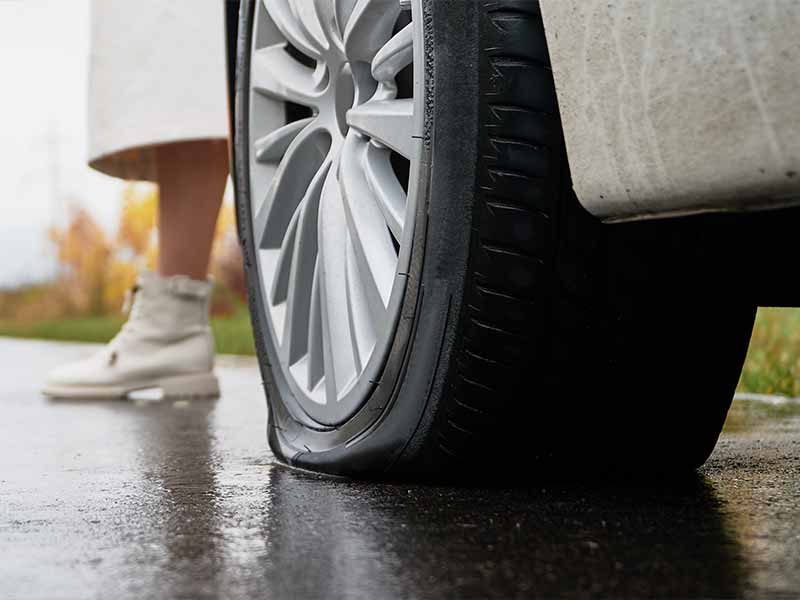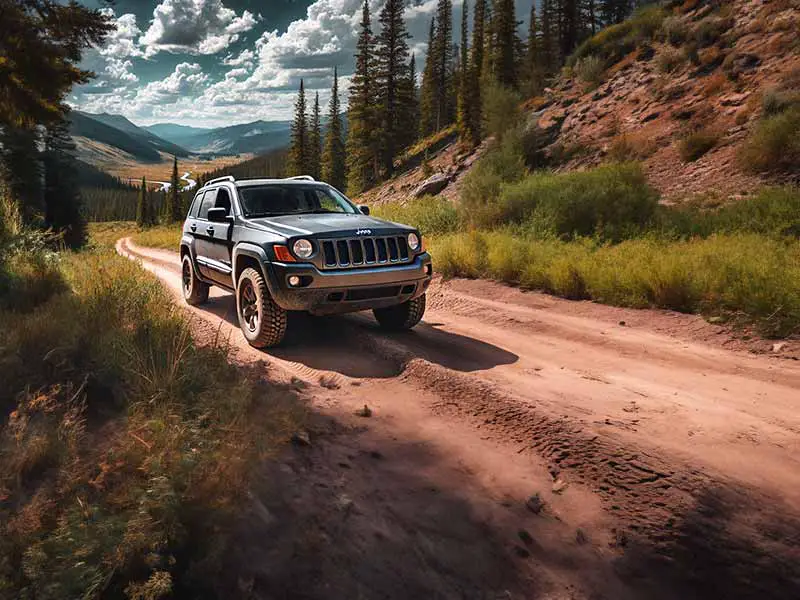Tires are arguably the most important component of your car or truck. They are the connection between the vehicle and the road. And as your tread wears down, your tires lose performance.
But tires are expensive, and taking time out of your busy schedule to have some new tires mounted is more than just inconvenient sometimes. The expense can cause you to need to make hard choices about how you need to spend your money.
Driving With Bald Tires
The two primary reasons driving on bald tires is dangerous are they can’t adequately channel water out from underneath the contact patch, and the rubber has become extremely thin and far more prone to punctures that could lead to catastrophic tire blowouts.
Newer tires will consistently outperform worn-out tires. But how significant is this difference in performance, and should you be concerned?
Let’s take a closer look.
Driving With Bald Tires Is Illegal
In almost every state, it is illegal to drive on bald tires. The overwhelming majority of states require that tires maintain a minimum tread depth of 2/32″. A few states will allow 1/32″ or worn tires that are perfectly smooth and completely bald.
Despite the laws of your particular state, we recommend that everyone consider replacing their tires well before the tire’s tread has worn down to 2/32″.
4/32″ of tire tread depth is the universally recognized tread depth that tire professionals recommend you consider replacing your tires.
We recommend tire replacement at this point because you will have used the vast majority of the value of your tire’s tread. They will have lost most of their ability to maintain traction in wet weather while still retaining enough to be significantly better and dealing with panic braking in wet conditions than when driving on bald tires.
How Long Can You Drive On A Bald Tire
We do not recommend driving on bald tires for any time, with the only exception possibly being to drive to your local tire shop to replace them, given that the road surface isn’t wet at all.
Even under the best circumstances, bald tires increase the risk of sudden blowouts because they are much thinner than new tires and can be easily punctured. A sudden loss of air pressure can lead to you losing control and a serious or fatal accident. This is an extremely dangerous issue.
Unexpected blowouts are dangerous in large part because they are “unexpected.” Even a relatively slow loss of air pressure can cause you to lose control if it happens when you need your tire’s tread to maintain traction and you’re unprepared for it to let you down.
We take the job our tire’s tread does for granted. Our tires perform admirably daily. But once they reach the end of their useful life we place ourselves at significantly increased risk if we don’t replace them promptly.
Bald Tires In Rain
When I was much younger, I had a combination of youthful ignorance and a lack of excess spending money that led me to push well beyond the limits that you should normally have your tires replaced. I can tell you firsthand that a sudden realization that your tires cannot perform precisely when you need them to do so is an unusually helpless feeling.
Bald tires can grip the road surface quite well in dry conditions. When the road isn’t wet, the need for grooved tread patterns isn’t necessary. A tire with no grooves can put more rubber in contact with the pavement and improve traction. This is why race cars use what’s commonly referred to as racing slicks.
Racing slicks aren’t the same as bald tires, though; you’re not on a race track with emergency vehicles on standby in case of an accident. Even race cars stop the race or switch over to rain tires when the track surface gets wet.
Hydroplaning
My experience was driving like I usually would in the rain when my tires were worn beyond the legal limit. What happened was I began to hydroplane. Hydroplaning is a situation where your tires cannot channel water out from underneath your tires fast enough, and your tires lose contact with the road surface.
The point at which you’ll stop hydroplaning depends on water depth, speed, and tread wear. When hydroplaning, your brakes are of no use, and your steering wheel has little effect. Since you’re gliding across the surface of the water like a skimboarder at the beach, you’re at the mercy of the rain.
Stopping Distance On Wet Roads
Another panic-inducing experience during my younger days with bald tires was realizing I needed to come to a sudden stop during a light rain.
Stopping distance on wet roads has a very strong connection to tread depth. As your tire tread blocks wear down, the tread grooves become smaller. The grooves allow water to escape from underneath your tires and provide biting edges that will enable the tire to better grip wet pavement.
The worn-out tires I was driving on had lost a significant amount of performance, and I found myself sliding helplessly toward the cars and trucks stopped ahead of me. Ultimately, I saved a few dollars and squeezed out another thousand miles or so from those tires. But the amount I saved by postponing buying tires didn’t cover the cost of replacing my front bumper or the higher insurance premiums.
Bald Tires Symptoms
The symptoms of bald tires aren’t usually felt until you’re driving in the rain. They may be louder or sound different on dry roads, but this likely won’t be noticeable since tires wear down gradually. If your bald tires are otherwise in good shape, they should grip well on dry roads.
The most common symptoms are much longer stopping distances on wet roads and frequent sensations of losing traction when hitting puddles and standing water.
Difference Between Worn Tires And Bald Tires
Worn tires are usually considered to be 4/32″ of remaining tread or more. Bald tires are considered to be 2/32″ of remaining tread or less.
Occasionally visually inspecting your tire treads can help you be aware of when you have very little tread left. A tread depth gauge is a good tool to keep in your glove box, but understanding how to read wear bars on tires is usually enough for most people to identify when it’s time to replace them.
Tread Depth Gauge
A tread depth gauge is the best way to accurately measure the current amount of remaining tread on your worn tires. They’re a bit overkill for many, but they are handy for better measuring how close your tires are to being completely worn and diagnosing uneven wear.
There are several different types of gauges for measuring your tire tread’s current depth, but I recommend picking up a dial-style depth gauge. They’re usually found for less than $10 and are much easier to read than the plunger-style gauges that are much more common.
The Penny Test
The penny test is a handy alternative that can give you a little more accuracy than eyeballing the wear bars when you don’t have a depth gauge handy. You can’t really get exact measurements, but you can more accurately gauge how close you are to 4/32″.
The test works by simply inserting a penny upside down into one of the main tread grooves of your tires. If you can see all of Lincoln’s head, it’s time to replace your tires immediately. If you can see all of Lincoln’s forehead, you should consider replacing your tires. If any of Lincoln’s forehead is covered, you can hold off on purchasing new tires.
Wear Bars
Wear bars are small raised bumps at the bottom of the deep grooves of most tires. These bumps or bars are 2/32″ high. Once your tires have worn down to the point that the wear bars are flush with the top of your tire’s tread blocks, you know you’ve pushed past the legal limit for tire wear in most states.
Bald Tires Vs New Tires
Driving on bald tires, when compared to new tires, may not feel different at all when the weather is nice. Sudden tire failure is the real problem, whether it’s a sudden loss of tire pressure or a suddenly losing control of your car or truck.
New tires have an additional 10/32″ or more of rubber between the pavement and the pressurized inside of the tire. This might not sound like much, but it can be the difference between safely arriving at your destination and ending up in a ditch.
Resources
Below are some links you may find helpful when learning about tires
- Bald tires: Knowing the what, why, signs, and risks – Bridgestone
- Safety risks of worn tires – Consumer Reports
Final Thoughts
I get it. New tires are expensive, and taking time out of your day to go sit in a waiting room is not what you want to be doing with your day. But your car tires are extremely important to your safety and the safety of others you share the road with.
The downside of driving on bald tires greatly outweigh the downsides of spending a bit of money and time you’d rather not part with.
Good luck and happy motoring.







